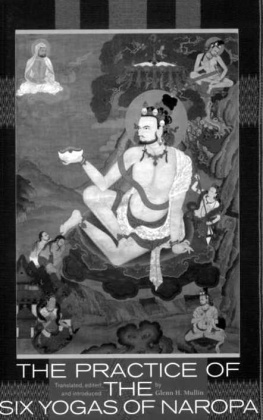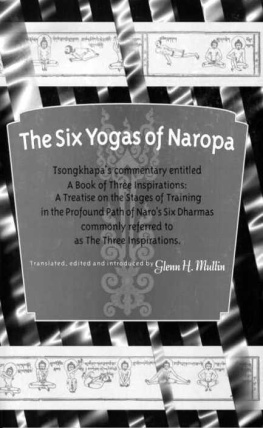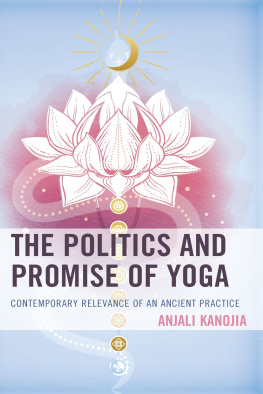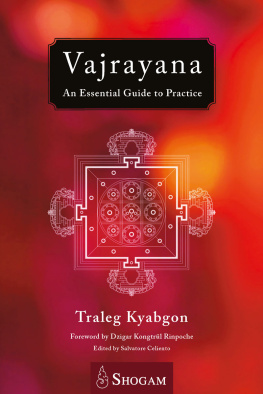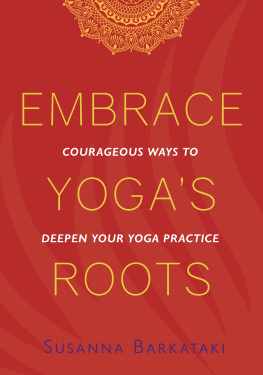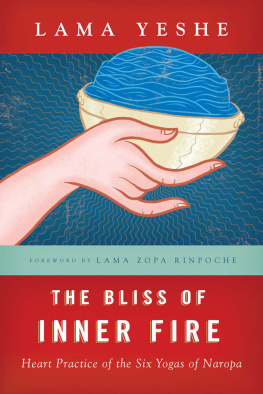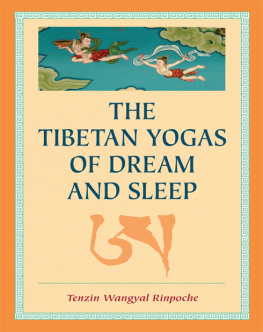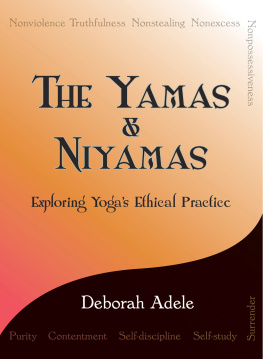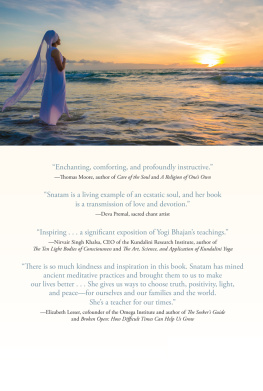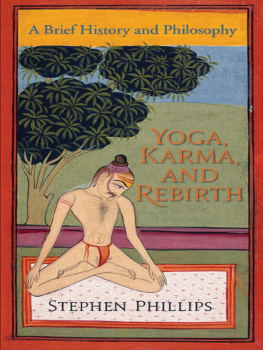Glenn H. Mullin - The Practice of the Six Yogas of Naropa
Here you can read online Glenn H. Mullin - The Practice of the Six Yogas of Naropa full text of the book (entire story) in english for free. Download pdf and epub, get meaning, cover and reviews about this ebook. year: 2006, publisher: Snow Lion Publications, genre: Religion. Description of the work, (preface) as well as reviews are available. Best literature library LitArk.com created for fans of good reading and offers a wide selection of genres:
Romance novel
Science fiction
Adventure
Detective
Science
History
Home and family
Prose
Art
Politics
Computer
Non-fiction
Religion
Business
Children
Humor
Choose a favorite category and find really read worthwhile books. Enjoy immersion in the world of imagination, feel the emotions of the characters or learn something new for yourself, make an fascinating discovery.
- Book:The Practice of the Six Yogas of Naropa
- Author:
- Publisher:Snow Lion Publications
- Genre:
- Year:2006
- Rating:5 / 5
- Favourites:Add to favourites
- Your mark:
- 100
- 1
- 2
- 3
- 4
- 5
The Practice of the Six Yogas of Naropa: summary, description and annotation
We offer to read an annotation, description, summary or preface (depends on what the author of the book "The Practice of the Six Yogas of Naropa" wrote himself). If you haven't found the necessary information about the book — write in the comments, we will try to find it.
The Practice of the Six Yogas of Naropa — read online for free the complete book (whole text) full work
Below is the text of the book, divided by pages. System saving the place of the last page read, allows you to conveniently read the book "The Practice of the Six Yogas of Naropa" online for free, without having to search again every time where you left off. Put a bookmark, and you can go to the page where you finished reading at any time.
Font size:
Interval:
Bookmark:

Translated, edited and introduced by Glenn H. Mullin
Although it is complete in its own right and stands well on its own, this collection of short commentaries on the Six Yogas of Naropa, translated from the Tibetan, was originally conceived of as a companion reader to my Tsongkhapa's Six Yogas of Naropa (Snow Lion, 1996).
That volume presents one of the greatest Tibetan treatises on the Six Yogas system, a text composed by the Tibetan master Lama Jey Tsongkhapa (1357-1419)-A Book of Three Inspirations: A Treatise on the Stages of Training in the Profound Path of Naropa's Six Yogas (Tib. Zab lam na ro'i chos drug gi 'khrid yig yid ches gsurn ldan) (hereafter referred to as A Book of Three Inspirations). Lama Jey Tsongkhapa was the founder of the eclectic Geluk school and the root guru of the First Dalai Lama (1391-1475). The introduction to that work gives a lengthy summary of the history and contents of the tradition of the Six Yogas of Naropa, which is not repeated here.
The work of preparing Tsongkhapa's Six Yogas of Naropa led me to read over a dozen classical Indian and Tibetan treatments of the Six Yogas. Six of those texts are included here: a brief verse work by the Indian mahasiddha Tilopa (988-1069), who is regarded as the original formulator of the system of the Six Yogas; a slightly longer verse work by Tilopa's chief disciple, known to history as Pandita Naropa (10161100), after whom the system is named; a commentary found in Lama Jey Tsongkhapa's Collected Works (Tib. gSung 'bum), entitled A Practice Manual on the Six Yogas of Naropa: Taking the Practice in Hand (Tib. Na ro'i chos drug gi dmigs skor lag to len tshul, hereafter referred to as A Practice Manual on the Six Yogas), which is much shorter in length than his formal treatise and focuses exclusively on the yogic techniques and meditations of the tradition; Gyalwa Wensapa's (1505-1566) presentation of "the three blendings," an important aspect of and also an alternative name for the Six Yogas; the First Panchen Lama's (15681662) treatment of the yogas, which emphasizes the first and fourth of the six yogas, i.e., the yogas of inner heat and of consciousness transference; and, lastly, a small text found in the collected works of the nineteenth-century lama Jey Sherab Gyatso (1803-1875), which was compiled by one of his disciples from a public discourse given by Jey Sherab Gyatso in 1836 on Tsongkhapa's A Book of Three Inspirations.
The above list of the six texts is in the order of their historical appearance as literary compositions. In this volume, however, I have placed the works by Jey Sherab Gyatso and Gyalwa Wensapa respectively as Chapters Three and Four, thus arranging them before the works by Tsongkhapa and the First Panchen Lama, who lived earlier in history than they. My logic in arranging them in this way is that the texts by Tilopa and Naropa in Chapters One and Two, although brief, show the roots of the tradition. Jey Sherab Gyatso's Notes in Chapter Three works well as an introduction to the overall approach taken to the Six Yogas, and describes how the general Buddhist trainings are used to prepare the mind of the practitioner for tantric endeavor. Gyalwa Wensapa's treatise in Chapter Four presents the underlying dynamic on which the Six Yogas tradition is based, namely "the three blendings." Lama Tsongkhapa's A Practice Manual on the Six Yogas in Chapter Five presents the nuts and bolts of the actual yogic disciplines. Finally, the First Panchen Lama's text in Chapter Six provides an excellent summary of the tradition, with emphasis on the inner heat and consciousness transference yogas.
These six translations were prepared with the guidance and assistance of various lama friends. When studying Tsongkhapa's A Book of Three Inspirations with Ven. Doboom Tulku, one of my root gurus, we also looked at parts of Tsongkhapa's A Practice Manual on the Six Yogas. A few months later I carefully read through this latter text with Ven. Ngawang Pendey, a wonderful Dharma friend from Drepung Loseling. With Ngawang Pendey I also read through several short commentaries on Tsongkhapa's A Book of Three Inspirations, including that by Jey Sherab Gyatso which forms the substance of Chapter Three, and also Gyalwa Wensapa's Handprints of the Path of the Six Yogas of Naropa: A Source of Every Realization, herein placed as Chapter Four. Later I rechecked several sections of these works with Geshey Lobzang Tenzin, also of Drepung Loseling. The texts by Tilopa and Naropa, and also the treatise by the First Panchen Lama, were prepared a year later while I was on a teaching tour in Italy. There the most learned and accomplished master Geshey Jampa Gyatso of Sera Jey Monastery, a lord of the Six Yogas tradition who for the past almost twenty years has been the resident teacher at Istituto Lama Tzong Khapa near Pisa, kindly made time in his busy schedule to nurse my understanding through these intensely terse and difficult works, and also took time to re-read difficult passages of the other texts in this volume. His wisdom, learning, humor and profound realization brought out their essence like butter churned from milk.
A number of Western friends also helped me in getting the manuscript into its final form. Jimmy Apple at the University of Wisconsin checked dates and historical references. Pierre Robillard and Michael Wurmbrand did some indispensable leg work on obscure points in the texts. Lulu Hamlin, Hilary Shearman, Debby Spencer and Renee Turolla offered useful suggestions. Finally, as always, my seven children fired my imagination and provided much inspiration.
It is my hope that these six translations will give tantric enthusiasts a sense of the esoteric and profound nature of the tradition known in Tibetan as the Naro Choe Druk, as well as of its historical continuity.
The authors whose works are translated in this volume frequently quote Indian and Tibetan texts. Throughout the volume these titles are simplified for the benefit of the general reader but are listed in a more formal manner at the back of the volume. The first section of the list of texts quoted gives Indian texts and includes both the original sutras and tantras taught by the Buddha and the treatises by later Indian masters. The second section contains indigenous Tibetan works.
The original tantras taught by the Buddha are usually named after a particular mandala deity, and generally in the text I have put these in an abbreviated Anglicized Sanskrit. An example is The Hevajra Tantra. The titles of texts by later Indian masters generally are more translatable into English, and therefore I have taken the liberty of doing so with them. An example is The Five Stages by the Indian master Nagarjuna. The titles of indigenous Tibetan works also seem to translate well into English; an example is Tsongkhapa's A Lamp on the Five Stages.
Throughout the text Tibetan personal and place names appear as they are pronounced and not as they are formally spelled, due to the number of silent letters used in Tibetan syllables, for example, "Khedrub Norzang Gyatso" rather than "mKhas sgrub nor bzang rgya mtsho." Those wishing to check the formal spellings can refer to the glossary at the back of the volume.
Font size:
Interval:
Bookmark:
Similar books «The Practice of the Six Yogas of Naropa»
Look at similar books to The Practice of the Six Yogas of Naropa. We have selected literature similar in name and meaning in the hope of providing readers with more options to find new, interesting, not yet read works.
Discussion, reviews of the book The Practice of the Six Yogas of Naropa and just readers' own opinions. Leave your comments, write what you think about the work, its meaning or the main characters. Specify what exactly you liked and what you didn't like, and why you think so.

